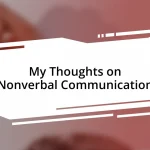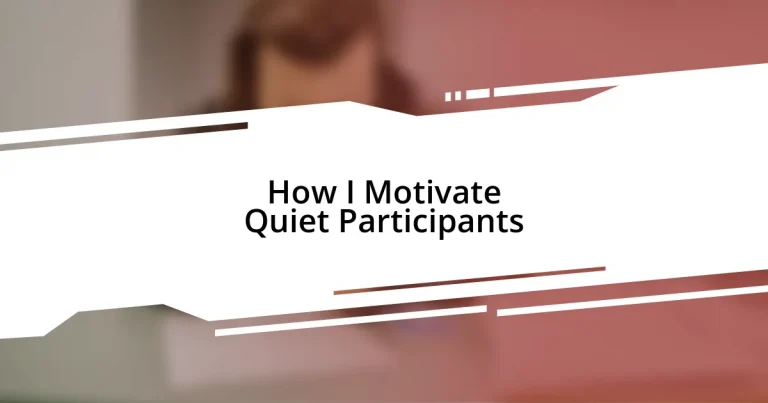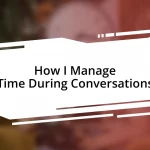Key takeaways:
- Engage quiet participants by recognizing different communication styles, such as reflective, written, and visual methods.
- Build trust through consistent engagement, casual discussions, and personal follow-ups to make participants feel valued.
- Create an inclusive environment by fostering safety, encouraging diverse perspectives, and implementing anonymous feedback mechanisms.
- Utilize engaging activities, positive reinforcement, and celebrate contributions to encourage quieter team members to share their insights.
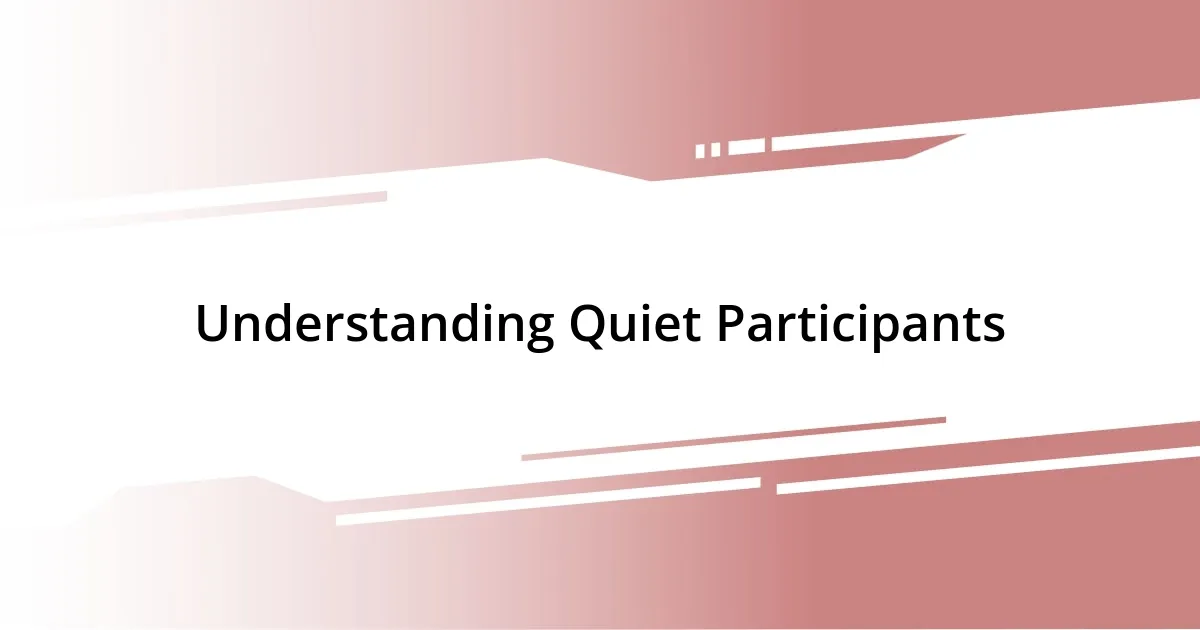
Understanding Quiet Participants
Quiet participants can often be overlooked in group settings, but they have unique perspectives that warrant attention. I remember a meeting where one of our most reserved team members finally shared her thoughts after a few nudges. Her insights changed the entire direction of our project, making me realize how valuable their quiet contributions can be.
It’s easy to underestimate quiet participants, assuming they lack ideas or confidence. But what if they are simply processing their thoughts more deeply? I once had a colleague who rarely spoke up during discussions. When I took the time to ask him for his opinion in a one-on-one chat, he opened up about some brilliant solutions he’d been mulling over, which I would have never known if I hadn’t reached out personally.
Understanding quiet participants also means recognizing the emotional landscape they navigate. They may feel anxious or uncertain in large groups, leading them to hold back. I’ve found that when I create a welcoming atmosphere, like starting with smaller group discussions, their comfort level grows, encouraging them to share more freely. Aren’t we all looking for that safe space where our voices can be heard?
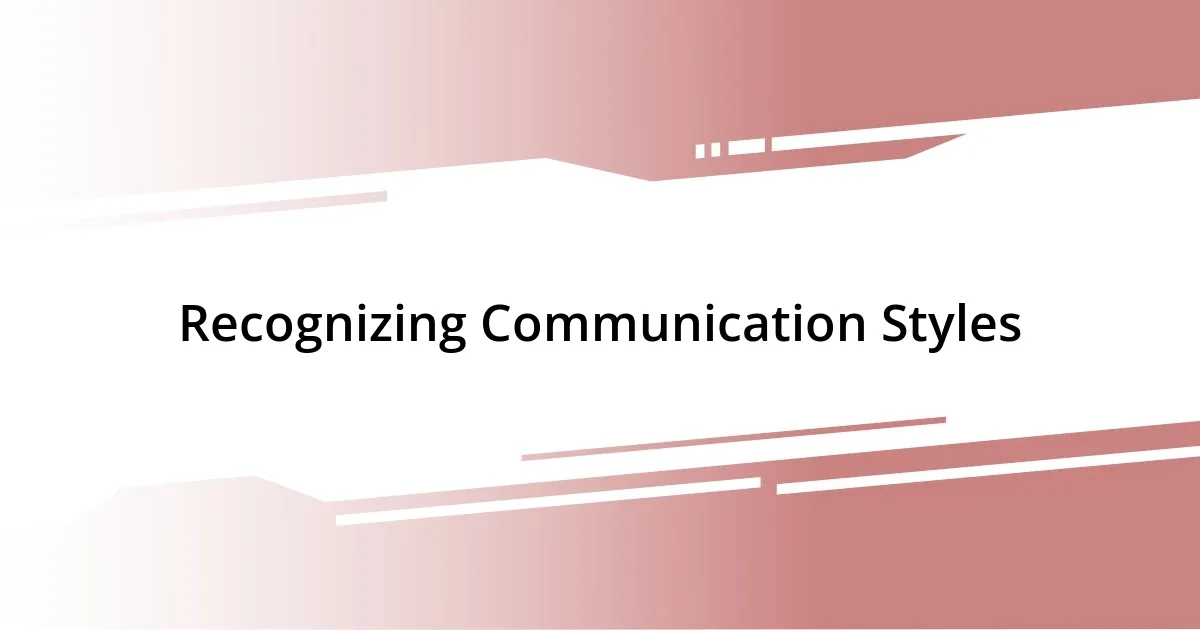
Recognizing Communication Styles
Recognizing different communication styles is essential for engaging quiet participants. I’ve noticed that some people express themselves best through written communication. For instance, in a team brainstorming session, I encouraged everyone to jot down their ideas first and then share them aloud. This simple shift allowed quieter participants to gather their thoughts and contribute meaningfully without the pressure of speaking up immediately. It was refreshing to see how vibrant the discussion became when everyone had the chance to express themselves in their preferred style.
Here are some key communication styles to watch for:
– Reflective: These individuals think deeply before speaking, often leading to insightful contributions when encouraged.
– Visual: They may prefer using diagrams or charts to convey their ideas, rather than verbal dialogue.
– Written: Some communicate best through emails or messages. Inviting them to share their thoughts this way can yield valuable insights.
– One-on-One: Quiet participants may be more comfortable expressing their thoughts in a more private setting, so personal check-ins can be beneficial.
Being attuned to these styles creates a richer dialogue and ensures everyone’s voice is heard.
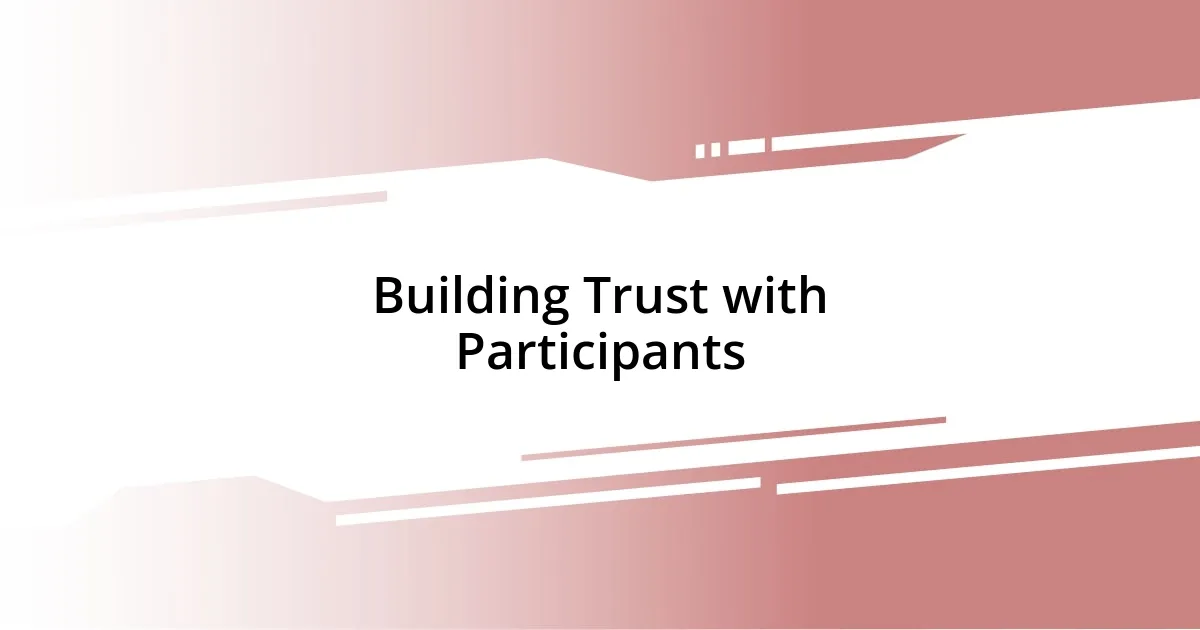
Building Trust with Participants
Building trust is pivotal in engaging quiet participants effectively. One experience that stands out for me was during a team project where trust issues lingered in the room. I made it a point to start our meetings with a casual and open discussion, allowing everyone, especially the quieter members, to share personal stories or thoughts. This approach not only created a welcoming environment but also laid the groundwork for more honest and productive conversations later. It’s amazing how opening up a little can influence the entire group dynamic.
In my opinion, establishing trust involves consistent and genuine engagement. I remember following up with one quiet participant after a meeting. I reached out privately, thanking him for his contributions and expressing genuine interest in his ideas. To my surprise, he shared several innovative concepts that he hadn’t voiced in the larger group. This experience reinforced my belief that showing authentic appreciation helps quiet participants feel valued and more willing to share.
Here’s a simple comparison of ways to build trust with participants:
| Method | Description |
|---|---|
| Casual Opening Discussions | Create a relaxed space to encourage personal sharing. |
| Personal Follow-Ups | Reach out individually to express gratitude and interest. |
| Consistent Engagement | Regularly check in to reinforce trust and openness. |
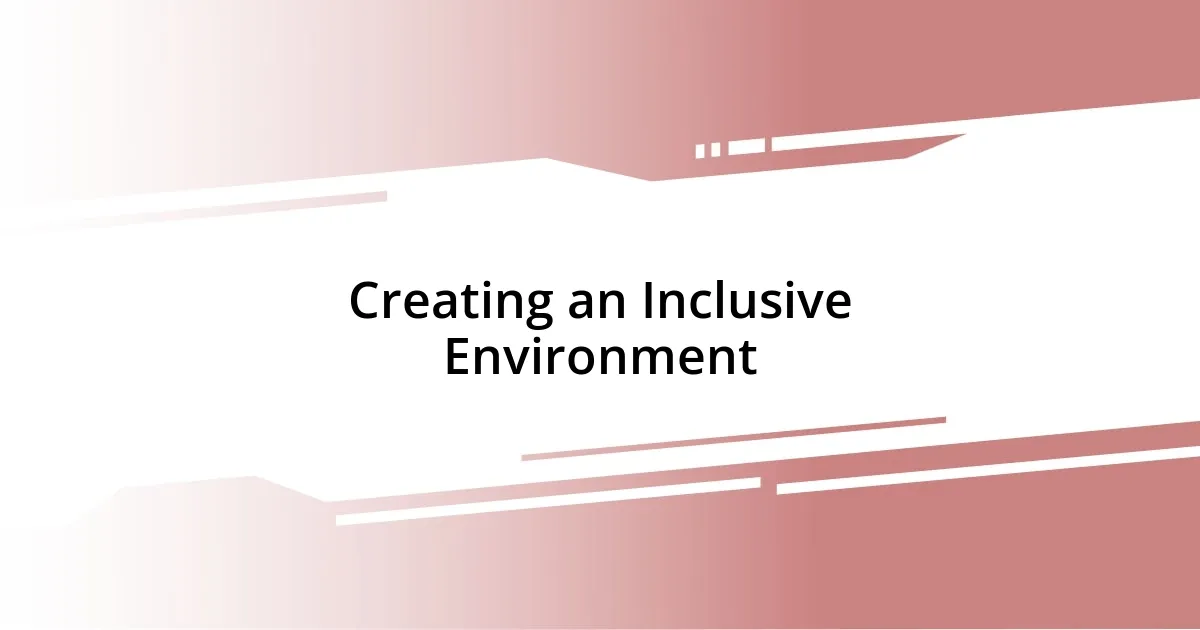
Creating an Inclusive Environment
Creating an inclusive environment starts with fostering a sense of safety. I recall a workshop where I invited participants to share a silent moment before beginning our discussions. It felt powerful to see people take deep breaths and settle in, creating a calm trust that loosened their initial hesitations. How can small moments like this transform our interactions?
Embracing diversity is crucial as well. I’ve witnessed how incorporating different perspectives can enhance group dynamics. During a project kickoff, we shared our backgrounds, emphasizing cultural differences and unique experiences. This openness not only brought laughter but strengthened our cohesion, making it clear that each person’s voice was integral to our overarching goal. When we value the diverse fabric of our teams, don’t we all benefit?
It’s also essential to encourage feedback continuously. I once implemented a simple suggestion box for our team, allowing everyone to contribute thoughts anonymously. The outpouring of feedback was surprising, with quiet team members feeling safe to share their perspectives without the apprehension of being judged. Isn’t it incredible how anonymity can empower those who might otherwise hold back?
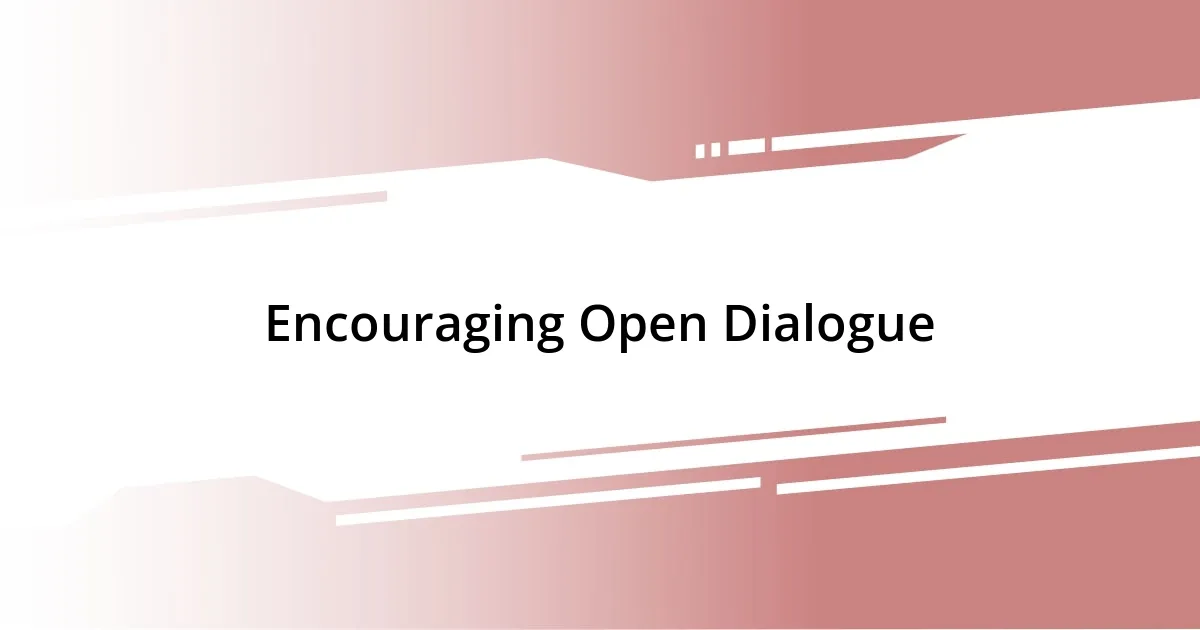
Encouraging Open Dialogue
Open dialogue is vital in bringing forward the voices of quiet participants. I remember hosting a brainstorming session where the energy was electric, yet I noticed some faces looking overwhelmed. To address this, I introduced a round-robin format, where each person had a moment to speak without interruption. It was during these quiet moments that I witnessed unexpected insights emerge, almost like uncovering hidden gems. Isn’t it fascinating how providing a structured space can encourage thoughtful contributions?
I also discovered that using open-ended questions invites deeper reflection. In one meeting, instead of asking what everyone thought about a topic, I prompted, “What concerns do you have about this project?” The shift in language encouraged my quieter colleagues to express their thoughts, which revealed valuable perspectives we hadn’t considered. This simple change felt like we were unlocking a treasure chest of ideas. Don’t you find it powerful when a question leads to someone finally sharing what they’ve been holding back?
Lastly, I find that incorporating informal check-ins can significantly ease participants into the discussion. Before a recent meeting, I took a moment to ask everyone how they were doing—away from the agenda. As we shared small insights about our week, the previously tense atmosphere transformed into genuine camaraderie. It reminded me of how important it is to connect on a human level first. How much more comfortable would we all feel if we started our interactions with a shared moment of humanity?
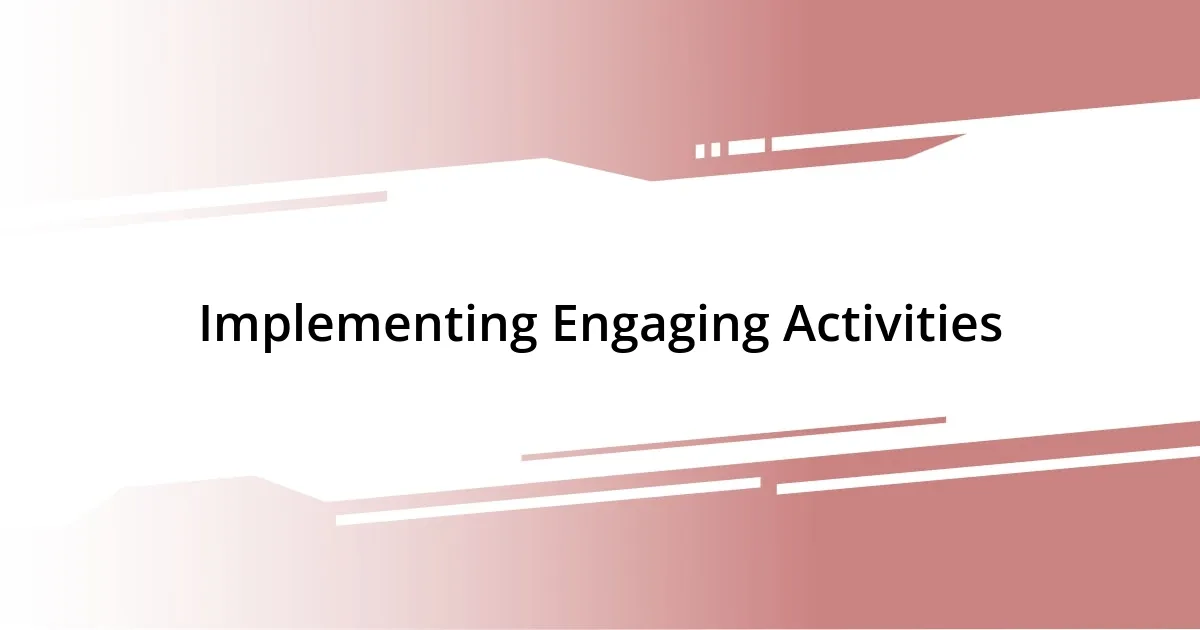
Implementing Engaging Activities
Engaging activities can truly transform the energy of a group. During a recent team-building exercise, I divided participants into small groups to solve a fun puzzle together. I noticed how the quiet ones began to share ideas in a less intimidating setting, breaking their silence as everyone rallied around a shared goal. It’s amazing how collaborative tasks can unlock participation, isn’t it?
I also love incorporating creative elements into discussions. Once, I introduced drawing prompts to encourage expression. I remember watching a colleague who typically held back, completely engrossed in visualizing her thoughts. When everyone shared their sketches, it sparked a lively conversation, revealing insights that might have remained hidden. Have you ever seen someone’s creativity light up the room?
Utilizing role-playing activities has proven effective in my experience as well. I organized a scenario where participants acted out various stakeholder perspectives in a project. The initial hesitance melted away as the group immersed themselves in different roles, fostering empathy and sparking conversations that included everyone. Doesn’t stepping into someone else’s shoes just offer a fresh view on collaboration?
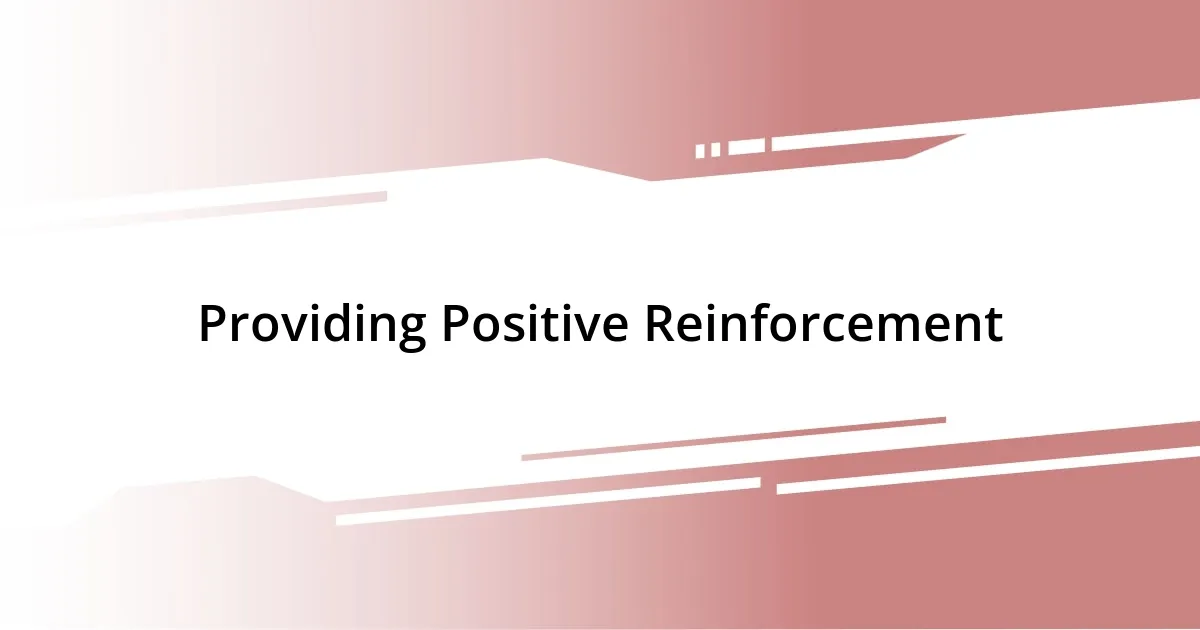
Providing Positive Reinforcement
Providing positive reinforcement creates a nurturing environment that encourages quiet participants to speak up. I remember one meeting where I noticed a shy team member hesitating to share her ideas. After hearing her perspective, I made a point to acknowledge her contribution in front of everyone, saying, “That’s a great point! It really adds depth to our discussion.” The way her face lit up in response was proof of the power of simple recognition; it can be a catalyst for more open dialogue. Isn’t it remarkable how a little encouragement sparks the confidence to speak up?
It’s also essential to tailor your reinforcement to individual preferences. For instance, I had a colleague who thrived on written acknowledgment. I made it a habit to send a brief thank-you email after meetings, highlighting her contributions. Over time, I noticed she became more willing to share her thoughts in person as well. How can we customize our approach to better support the unique needs of our quiet participants?
Finally, I find that celebrating small wins reinforces positive behavior. In one of my workshops, I started putting a “kudos” section on the agenda, where we’d take a moment to appreciate contributions, no matter how small. Watching participants beam with pride as their efforts were recognized created a ripple effect. It made the environment feel more inviting and energized. Have you ever observed how recognition not only uplifts those being acknowledged but also cultivates a sense of community within the group?











